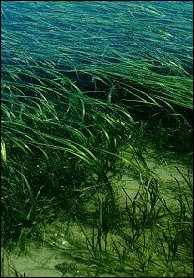Difference between revisions of "Seagrass meadows"
(→Distribution) |
(→Distribution) |
||
| Line 17: | Line 17: | ||
| − | [[image:Seagrass distribution. | + | [[image:Seagrass distribution.GIF|center|thumb|350px|caption|Seagrass distribution <ref>UNEP-WCMC (World Conservation Monitoring Centre) 2001</ref>]] |
==Requirements for development== | ==Requirements for development== | ||
Revision as of 10:22, 18 July 2008
This article describes the habitat of the seagrass meadows. It is one of the sub-categories within the section dealing with biodiversity of marine habitats and ecosystems. It gives an overview about the characteristics, distribution, zonation, succession, biota, threats, functioning and adaptations of the organisms that live in seagrass meadows.
Introduction
Seagrass communities are highly productive and dynamic ecosystems. Seagrasses are not true grasses but rooted vascular (flowering) plants of terrestrial origin that have successfully returned to the sea. This return needs several adaptations that allow them to live in submerged ocean regions. The sediments where they settle on can be muddy, rocky or sandy. Seagrass ecosystems are species rich and include endangered species such as dugongs and seahorses. They are very important for the geomorphology and ecology of coastal ecosystems by processes such as stabilizing sediments, recycling nutrients and forming the base of the oceanic detrital food webs. Currently, they are facing many threats, induced by humans and nature. [1]

Distribution
Seagrasses generally inhabit the protected shallow waters of temperate and tropical coastal area. The most extensive areas are found in the tropics. A few species occur in colder regions. There are several distinct areas of seagrass meadows. These areas are Indo-Pacific, central-America, the seas around Japan and Australia and the Mediterranean Sea.
Requirements for development
Seagrasses have several requirements to develop:
- Salt or brackish water is absolutely necessary.
- They need enough light for photosynthesis. They need an excess of 11% of
the incident light in the surface water. Therefore, they grow in the shallow regions along the coasts and depth limits are set. The average depth is a few meters, but they are recorded to 70 meters in clear water.
- When the water becomes too turbid (sediment suspension), the plants ant their
dependent organisms can be destroyed. For an optimal growth, the plants need clear water.
- They need a soft substrate such as mud or sand, but some species can
also grow on rocky sediments and corals.
- The most suitable place is a gently sloping coast, with little or no tidal
currents or strong waves.
Zonation
Different species grow in different places. This causes zonation. The first zones are the high and mid intertidal. This is situated just below the mangrove vegetation. The colonization species are Halodule wrightii and Cymodocea rotundata on more stable substrates with some sand-dwelling seaweeds such as Chondria, Hypnea and Caulerpa.
The mid and low intertidal are dominated by the climax vegetation Thalassia hemprichii on stable substrates. Numerous Pinna and some seaweeds are present close to the low water margin. The subtidal fringe is an area with Syringodium isoetifolium. This seagrass has tough, cylindrical leaves. Enhalus acoroides sometimes occurs here. This seagrass also has very large and tough leaves. In the subtidal, the species Halophila stipulacea and Halodule uninervis occur on new substrates. On stabilized substrates, Thalassodendron ciliatum and Enhalus acoroides grow.
European genera are Zostera, Posidonia and Cymodocea. Zostera or eelgrass is a small genus of widely distributed seagrass, with Z. marina and Z. noltii occurring in Europe. It is found on sandy substrates or in estuaries submerged or partially floating. The meadows are important for sediment deposition, substrate stabilization, as substrate for epiphytic algae and micro-invertebrates and as nursery grounds. Posidonia oceanica is another European species. It is endemic to the Mediterranean Sea. They occur in dense meadows or along channels in sands. On beaches, balls of fibrous material from the foliage of the plant can be found. This is known as egagropili. Cymodocea nodosa is a seagrass that occurs in the Mediterranean Sea. It lives on sandy bottoms in shallow waters. It never grows below 10 meters depth. [4]
Zostera marina [5]
Zostera noltii [6]
Posidonia oceanica [7]
Posidonia oceanica egagropili [8]
Cymodocea nodosa [9]
References
- ↑ Denny M.W. Gaines S.D. 2007. Encyclopedia of tidepools & rocky shores. University of California Press. p. 705
- ↑ NOAA
- ↑ UNEP-WCMC (World Conservation Monitoring Centre) 2001
- ↑ Borum J. et al. 2002. European seagrasses: an introduction to monitoring and management. The M&MS project. p.95
- ↑ http://www.algaebase.org
- ↑ http://www.ru.nl/wetenschapsagenda/editie_19_-_18_06_08/nieuws/vm/jaargang_een/grootschalige/
- ↑ http://www.algaebase.org
- ↑ http://mallorcaphotoblog.wordpress.com
- ↑ http://www.algaebase.org
Please note that others may also have edited the contents of this article.
|





